Most people associate Budai (布袋) in the southwestern corner of Chiayi County with fish, but that isn’t the township’s only claim to fame. It’s an excellent place to see waterbirds, among them the endangered black-faced spoonbill. There are also relics of the now-defunct salt industry.
Ecotourism and history are two of my favorite pastimes, but last week’s excursion was devoted to buying and eating seafood. I hadn’t been to Budai Harbor Fish Market (布袋港魚市場) for some years, and as we drove toward the town, I wondered if it had changed much.
Despite the striking success of the makeover that transformed part of Taipei Fish Market into Addiction Aquatic Development (AAD, 上引水產), it turned out I was right in predicting that the people running Budai Harbor Fish Market hadn’t pushed through dramatic reforms. Or even minor adjustments, for that matter.
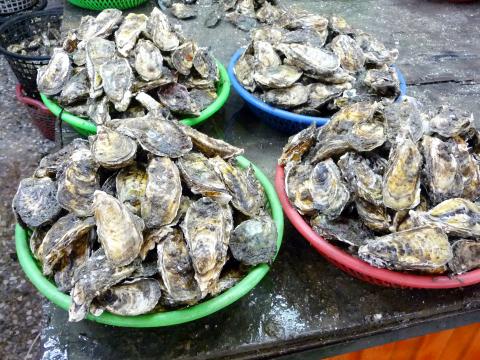
Photo: Steven Crook
If they visited AAD, they perhaps weren’t impressed by its soft, boutique hotel-style lighting. In Budai’s fresh-seafood emporium, as in most of Taiwan’s markets, your eyes have to constantly adjust between dank gloom and the white glare of naked light bulbs. The 40-odd eateries that operate inside the market do a roaring trade on weekends, so there’s no pressing reason to update the menus or refresh the decor. Southern folks tend to be conservative. Who wants premium sakes when you’ve got Taiwan Beer?
Having satisfied myself that nothing significant had changed, I set out to take photos in the fresh-produce area in the center of the market. Squeamish individuals may dislike the bloody fish heads, but I think local markets are visually delightful.
I also hoped to learn a bit more about seafood in Taiwan. I’ve never been much into eating creatures pulled out of the ocean, so I’ve not tried to remember the relevant vocabularly in English or Chinese.
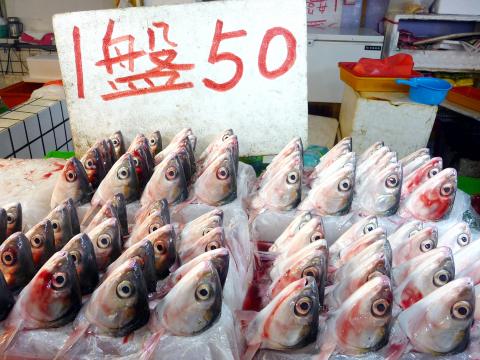
Photo: Steven Crook
The shallow waters just off Budai are dotted with bamboo platforms on which oysters are raised, and on busy days visitors to the market get through hundreds of oyster omelets (蚵仔煎). Identical omelets are available in night markets throughout Taiwan, but deep-fried oyster-filled bao (蚵仔包) are a true Budai specialty. One bao is a substantial snack; eat two and you mightn’t need any dinner.
If you’re looking for gifts for foodie friends here in Taiwan, what English and Italian-speakers call bottarga is an option. (I’d advise against trying to take it to North America or Europe because there’s no guarantee you’ll get it through customs.) In Chinese, it’s known as wuyuzi, (烏魚子, “black mullet roe’), and it’s made by deveining roe, salting and sun-drying it, and then pressing it so it’s as hard as cheddar. Under the name “Mullet bottarga of Kaohsiung County,” it’s recognized by the Slow Food Foundation for Biodiversity’s Ark of Taste as a Taiwanese foodway which dates from at least the 1624-1662 Dutch occupation of the Tainan area. It isn’t cheap; in the market, one catty (斤, jin, equal to 600 grams) costs up to NT$600.
If you’ve never had it, dried fish floss (魚鬆, yusong) is somewhat like the super-fine shredded pork that’s often added to congee. This product can be made from different fish, including marlin (the floss is a rich shade of orange) and bummalo (a lighter, sandier color). A couple of vendors manufacture small amounts on the spot.
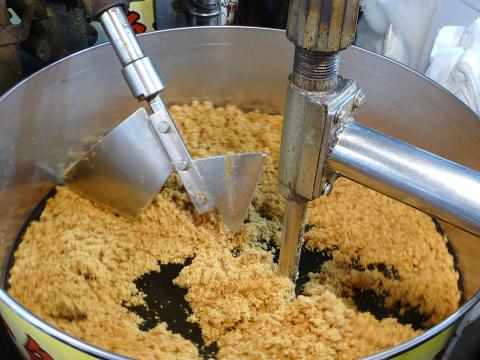
Photo: Steven Crook
There were also piles of tiny dried shrimps, freshly-caught grouper, slabs of imported salmon, and rows of mud crabs. The claws and legs of every crustacean were tied, even though it looked like the great majority of them had long given up the struggle. Ready-cooked items, popular in households where both parents are too busy with jobs to prepare meals from scratch, were also numerous.
One stall specializes in Japanese Spanish mackerel from the Penghu Islands, a fish whose flesh is often cut into chunks, battered with potato starch, deep fried, then served in a thick soup. Taiwanese know this hefty fish as tutuoyu (土魠魚). According to the “Taiwan Seafood Choice Guide” published by Academia Sinica at fishdb.sinica.edu.tw/eng/seafoodguide.php, consumers should think twice before ordering it because of fisheries-management issues.
Not all of the fresh food sold in the market qualifies as seafood. I noticed the corpses of a dozen big black frogs on top of a bucket filled with ice. The vendor — the only person working in the market who spoke to me in English — told me that these amphibians are farmed in Taiwan, not taken from the wild, and that they’re best enjoyed cooked in soup with lots of onion.
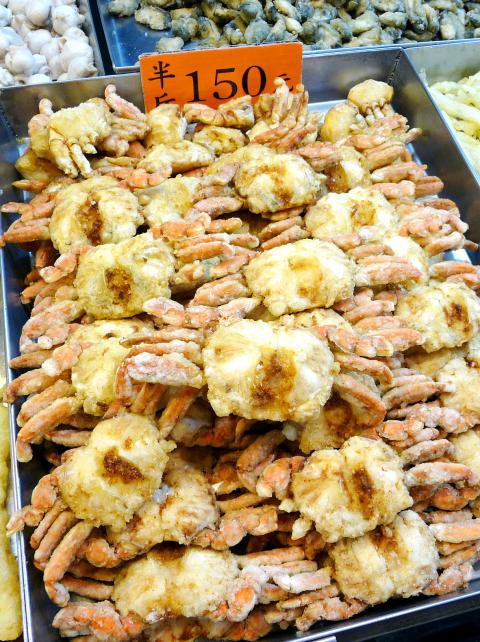
Photo: Steven Crook
Wanting to walk off our lunch, we made our way to one of the region’s more unusual sights. The High-Heel Wedding Church (高跟鞋教堂) is the centerpiece of a park bordered by Wenchang Street (文昌街) and Haixing Street (海興街), about 800m southwest of the fish market. Strictly speaking, it isn’t a house of worship, although weddings are sometimes held beneath its translucent blue roof.
The 17.8m-high, 25.2m-long open-sided structure was built by the Southwest Coast National Scenic Area Administration to attract tourists to the town. Judging by the number of people there last week, like the fish market, it’s still doing very well.
Steven Crook has been writing about travel, culture, and business in Taiwan since 1996. He is the co-author of A Culinary History of Taipei: Beyond Pork and Ponlai, and author of Taiwan: The Bradt Travel Guide, the third edition of which has just been published.
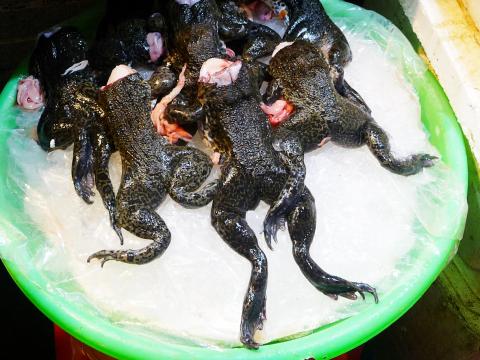
Photo: Steven Crook
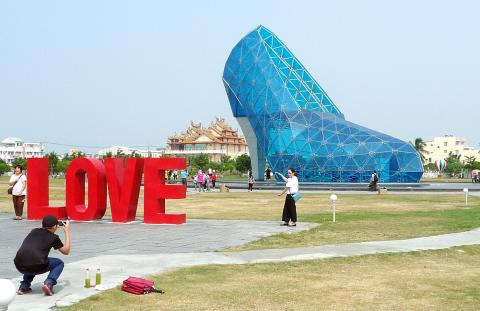
Photo: Steven Crook

May 26 to June 1 When the Qing Dynasty first took control over many parts of Taiwan in 1684, it roughly continued the Kingdom of Tungning’s administrative borders (see below), setting up one prefecture and three counties. The actual area of control covered today’s Chiayi, Tainan and Kaohsiung. The administrative center was in Taiwan Prefecture, in today’s Tainan. But as Han settlement expanded and due to rebellions and other international incidents, the administrative units became more complex. By the time Taiwan became a province of the Qing in 1887, there were three prefectures, eleven counties, three subprefectures and one directly-administered prefecture, with

It’s an enormous dome of colorful glass, something between the Sistine Chapel and a Marc Chagall fresco. And yet, it’s just a subway station. Formosa Boulevard is the heart of Kaohsiung’s mass transit system. In metro terms, it’s modest: the only transfer station in a network with just two lines. But it’s a landmark nonetheless: a civic space that serves as much more than a point of transit. On a hot Sunday, the corridors and vast halls are filled with a market selling everything from second-hand clothes to toys and house decorations. It’s just one of the many events the station hosts,

Among Thailand’s Chinese Nationalist Party (KMT) villages, a certain rivalry exists between Arunothai, the largest of these villages, and Mae Salong, which is currently the most prosperous. Historically, the rivalry stems from a split in KMT military factions in the early 1960s, which divided command and opium territories after Chiang Kai-shek (蔣介石) cut off open support in 1961 due to international pressure (see part two, “The KMT opium lords of the Golden Triangle,” on May 20). But today this rivalry manifests as a different kind of split, with Arunothai leading a pro-China faction and Mae Salong staunchly aligned to Taiwan.

Two moves show Taichung Mayor Lu Shiow-yen (盧秀燕) is gunning for Chinese Nationalist Party (KMT) party chair and the 2028 presidential election. Technically, these are not yet “officially” official, but by the rules of Taiwan politics, she is now on the dance floor. Earlier this month Lu confirmed in an interview in Japan’s Nikkei that she was considering running for KMT chair. This is not new news, but according to reports from her camp she previously was still considering the case for and against running. By choosing a respected, international news outlet, she declared it to the world. While the outside world